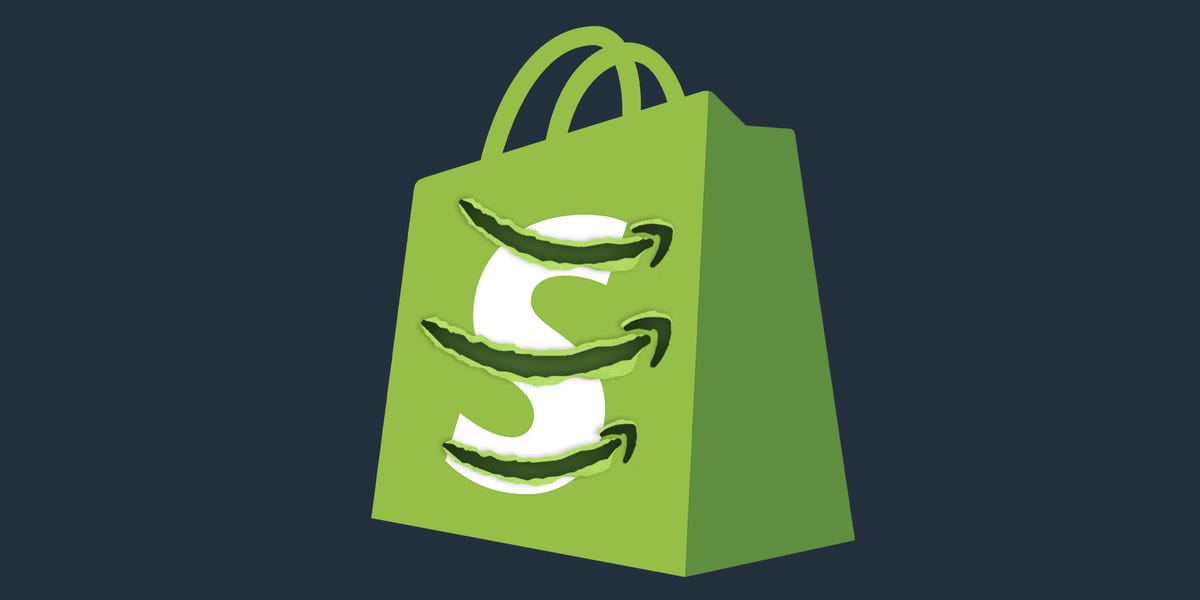- Internal documents reveal tension between Amazon and Shopify as they worked on a new partnership.
- Amazon and Shopify announced a new Buy with Prime app for Shopify on Wednesday.
- In a rare move, Amazon has to compromise and give concessions in return for Shopify’s cooperation.
Amazon dominates e-commerce. That’s the standard assumption. An internal document and interviews with insiders suggest this is beginning to change.
The internet giant has been trying to get its Buy with Prime service on Shopify’s merchant platform for months. It finally happened on Wednesday. But the untold story of how it happened reveals that Shopify exerted a surprising amount of leverage over the negotiations.
Buy with Prime let merchants offer Prime benefits, such as fast shipping and free delivery, on websites beyond Amazon.com. Online shoppers see a Buy with Prime button along with shipping information, and they can check out using the payment and shipping information already stored in their Amazon account.
Earlier this year, Amazon drew up plans to integrate Buy with Prime data with Shopify’s backend system. Amazon had hoped Shopify would support this so merchants could analyze data, like orders, returns, and traffic, directly in an upcoming Buy with Prime app for Shopify’s platform.
Shopify refused. Amazon had no choice but to let Shopify merchants view Buy with Prime-related metrics on its own backend console, not within the unified Shopify Admin tool, according to the internal Amazon document from April.
“Shopify has confirmed they will not invest in any BwP-specific analytics functionality, meaning our Merchant Console will be the only place merchants will have access to view and analyze this data,” the document stated.
This data integration was important because busy merchants often don’t have time to fetch data about their business from different portals and manually combine it. If Buy with Prime data wasn’t smoothly integrated into Shopify Admin, Shopify merchants might not use the Amazon feature much. That would be a blow to Amazon, which is trying to expand fee-generating services beyond its own e-commerce website and app.
Fast forward four months, and the two companies seem to have found a truce. On Wednesday, Amazon and Shopify announced a new Buy with Prime app for Shopify’s platform that lets merchants “automatically sync orders, promotions, catalog listings, and taxes within their Shopify Admin.”
Other parts of the tense negotiations didn’t go Amazon’s way, though, according to the document and people involved in the project. It’s a rare example of the company having to compromise and give concessions as it sought the cooperation of an increasingly powerful rival.
In one part of the Amazon document, it described Shopify as the “largest turnkey ecommerce service provider in the market.” And when the final deal was announced, Shopify’s payment-processing service ended up being the one used for all Buy with Prime transactions on the Shopify platform, a major concession by Amazon.
Amazon and Shopify declined to comment, beyond their public statements this week.
Project Santos
Buy with Prime was born out of a secret initiative, led by Amazon founder Jeff Bezos after the company started to worry about Shopify’s rapid growth. It was called Project Santos, as Insider previously reported.
In 2020, Shopify stock had soared and the company was worth about $130 billion. Initially, as Amazon executives scrambled to respond, there was talk internally of creating a full competing service. That would have taken Amazon back to a market it left in 2015 when it shut down its Webstore offering.
Instead, Buy with Prime emerged in April 2022. But even that caused tension between the two companies, with Shopify at one point warning its sellers against using it. Some analysts see Buy with Prime as a “Trojan Horse” that helps Amazon take share from Shopify.
Constant delays
The internal Amazon document described a Shopify-native Buy with Prime app as a “flagship” goal for Amazon’s top leadership because it would make Buy with Prime more appealing to Shopify merchants.
But Shopify repeatedly delayed the launch date and gave extended timelines, according to the document and people involved in the project who spoke on the condition of anonymity because they were not authorized to speak to the press.
Amazon had already pushed back the general availability date of the new Buy with Prime for Shopify app from late July to August 14, the document stated. Amazon expected even more delays because it wanted to launch with a new mixed-cart feature that lets shoppers buy multiple Buy with Prime products at once. Shopify only committed to adding that feature by the second quarter of 2024 at the earliest, or roughly 12 months later.
“We’ll need to delay our V1 launch even further,” the document said, referring to the first version of the app.
Shopify refused to commit to a firm launch date citing limited resources, said the people familiar with the project. The lack of interest was expected since Shopify “really disliked” it when Amazon first unveiled Buy with Prime last year, one of the people said. Wednesday’s announcement said the new app is still invite-only, and will be rolled out by the end of September to all US-based Shopify merchants who also use Amazon’s Fulfillment by Amazon service.
To speed up the mixed cart launch, a feature merchants and investors have been calling for, Amazon chose to build a “light” version that required few changes to Shopify’s system architecture. Amazon was willing to spend about 4 months building this on its own in return for Shopify’s commitment to provide support for the mixed cart feature later, according to the document.
“If Shopify improves their systems to support mixed-cart (i.e., no longer requiring Light Cart), the work wasted on the Amazon side is only the effort to build the Light Cart UI (~3-4 dev months),” the document stated. “While Shopify is aligned at a high level, we have not yet locked low level details with Shopify.”
Amazon was also worried about Shopify’s demand to add real-time shipment tracking for packages shipped through Amazon’s own logistics service, and sought to make it a priority. Amazon Logistics handles almost 70% of Buy with Prime orders, but Shopify doesn’t have tracking capabilities for those shipments, according to one of the documents.
“Inclusion of AMZL tracking into the Shop App is an area of strategic importance for Shopify and will likely be a point of contention if we do not prioritize this work,” the document said. Earlier this year, Shopify sold its logistics business, essentially giving up on competing against Amazon in this area.
Can Amazon stitch a customer journey together?
Another point of conflict was full measurement of click metrics, like views, checkout previews, orders, and latency. Amazon wanted Shopify’s help in getting that data at the merchant, product, and shopper levels, but “due to Shopify being unable to resource this work” by the launch of the first version of the app, Amazon decided to use less-robust internal metrics as a proxy.
“This implies we will not have the shopper-level granularity to stitch a customer journey together for deep-dive purposes and the metrics will be less precise,” the document said.
It’s unclear how many of these issues have been resolved. Amazon and Shopify said in their announcement Wednesday that the two companies “will continue to iterate together” to “roll out additional features in the future.”
Wall Street has been waiting
Wall Street has been anticipating the launch of the new Buy with Prime for Shopify app for some time. Almost every Shopify earnings call over the past year saw at least one question about it from analysts. During the most recent call in early August, Shopify President Harley Finkelstein appeared annoyed.
“Yeah, I mean, conversations with Amazon remain productive, but no news to share right now,” Finkelstein said during the call.
For some industry experts, Wednesday’s announcement lacked the granular details of the new service and almost appeared rushed.
“It seems more like a partnership announcement before the implementation was complete,” Mark William Lewis, CEO of Netalico Commerce, an online shopping consulting firm, told Insider.
A Shopify Payments win
For Shopify, the main highlight of Wednesday’s announcement was securing the payment processing part of the new Buy with Prime app. This is important because a large chunk of Shopify’s revenue comes from payment processing fees.
Internally, Amazon was worried about Shopify Payment’s low popularity among sellers. The internal Amazon document described this as the “biggest blocker for merchants not adopting the Shopify app” because they’ve already negotiated lower credit card fees with other payment providers, or they prefer receiving all payment processing through a single vendor, such as Stripe, the document said. Shopify charges an additional fee to sellers choosing to use a different payment provider.
A double-counting inventory problem
Amazon plans to eventually unify the Buy with Prime app with its multi-channel fulfillment service, which lets sellers use Amazon’s warehouses and shipping network for off-Amazon orders.
The document said this could increase merchant signups by simplifying onboarding and fixing a double-counting inventory problem, which is “a major concern for Shopify and a larger concern than previously anticipated for Amazon.”
As part of this effort, Amazon merged the two teams internally, according to people familiar with the move. It’s unclear when the unified app will launch.
Some bright spots
There have been some bright spots from the partnership. For example, the “Reviews from Amazon” feature, which displays Amazon reviews next to Buy with Prime products, has been a “gamechanger” for sellers, the document said. An internal study found that 61% of shoppers thought the feature gave them more confidence to purchase from a lesser-known merchant.
The document also listed the “north star and tenets,” or the guiding principles for the new Buy with Prime for Shopify app. The north star is to create “a native (i.e., built within Shopify systems) experience that is so compelling for shoppers, it is irresponsible for merchants not to offer it,” it said.
Among the 6-point tenets are prioritizing the growth of merchant sales volume and meeting Amazon Prime’s high bar of quick delivery and free returns. It also emphasized the need to solve conflict and build a “better together” service with Shopify.
“We believe we can build a ‘better together’ shopper and merchant experience with Shopify. We lean in to the key differentiators each company has to offer (e.g., Prime, MCF, Amazon App, Shop App) to ‘grow the pie,'” it said.
Do you work at Amazon? Got a tip?
Contact the reporter Eugene Kim via the encrypted-messaging apps Signal or Telegram (+1-650-942-3061) or email ([email protected]). Reach out using a nonwork device. Check out Insider’s source guide for other tips on sharing information securely.
Read the full article here





